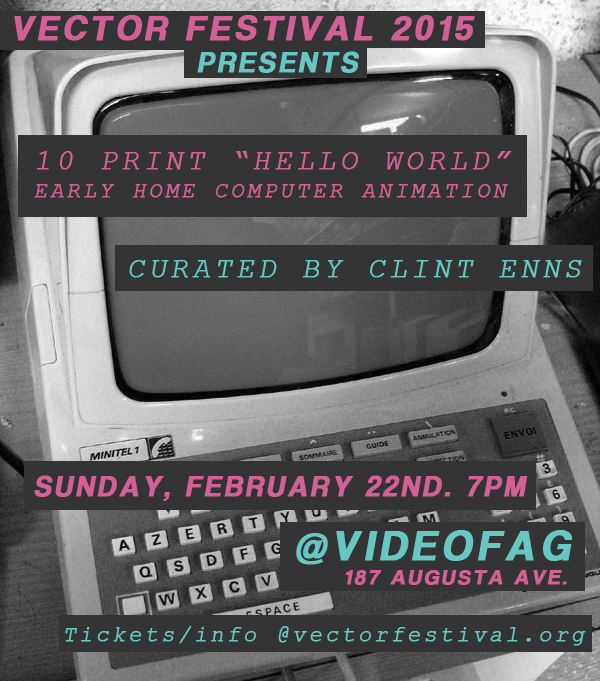
Sunday, February 22
Videofag | 7pm
Screening
Curated By Clint Enns
It is our pleasure to have Vector co-founder, artist and screening programmer, Clint Enns, back for Vector 2015! This year’s screening, “Hello World” is intended to be an extension of last year’s highly successful Code in Motion, a program presented by Vector featuring early computer animation made from 1951-1974. “Hello World” is the direct result of informal research into why the “teapot” has become an iconic symbol for computer art and features early examples of moving images produced on early home computer systems.
Hello World features a large array of home computing technologies including an anthology of early and experimental images created on a Videotex (a device that displays interactive content on a television screen) organized by Toronto curator Paul Petro titled Canadian Artists and Telidon (1984), Canadian poet bpNichol’s First Screening (1984) featuring a dozen kinetic poems programmed in Apple BASIC for the Apple IIe, and an excerpt from Cycles of 3s and 7s (1976), Tony Conrad’s extremely humorous performance on a pocket calculator. The program also presents canonical works by Larry Cuba, who is perhaps best known for his computer graphics that were featured in Star Wars Episode IV: A New Hope (1977), Loren Carpenter whose Vol Libre (1980) with its fractally generated landscapes, a technique he expanded on for Star Trek II: The Wrath of Khan (1982), was met with a standing ovation at SIGGRAPH and Manfred Mohr, one of the pioneers of digital and algorithmic art.
As a counter-point to the fairly abstract nature of the other works, Mary Kunuk’s Aqtuqsi (My Nightmare) (1996), produced through the Women’s Video Workshop of Igloolik (Arnait Video Productions), demonstrates how computer animation could be used in conjunction with Inuit styles of narration and John Whitney’s documentary A Personal Seach for the Complementarity of Music & Visual Art (1993) explores the concept of digital harmony and his own personal artistic methodology.
Although some of the films and videos in this program might be considered slow, the viewer is invited to mediate on works that were made in an era when it took a 48K computer program five minutes to load from a cassette tape. Finally, various television commercials are interjected throughout the program to satisfy those with ADHD, in addition to providing additional cultural context.
Program:
Tony Conrad, Cycles Of 3s And 7s (1976, 3 Minutes (Excerpt))
Manfred Mohr, Cube Transformation Study (1972, 30 Seconds)
Larry Cuba, Calculated Movements (1985, 6 Minutes) On 16mm
Bpnichol, First Screening (1984, 10 Minutes)
Canadian Artists And Telidon (1984, 20 Minutes)
Arnait Video Productions And Mary Kunuk, Aqtuqsi (My Nightmare) (1996, 5 Minutes)
John Whitney – A Personal Seach For The Complementarity Of Music & Visual Art (1993, 27 Minutes)
Loren Carpenter – Vol Libre (1980, 2 Minutes)
+ Various Home Computer Commercials From The Era